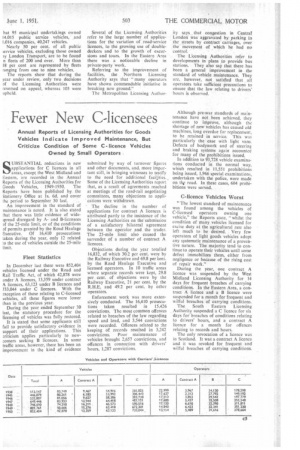Fewer New C-licensees
Page 43

If you've noticed an error in this article please click here to report it so we can fix it.
Annual Reports of Licensing Authorities for Goods Vehicles Indicate Improved Maintenance, But Criticize Condition of Some C-licence Vehicles Owned by Small Operators
SUBSTANTIAL reductions in new applications for C licences in all areas, except the West Midland and Eastern, are recorded in the Annual Reports of the Licensing Authorities for Goods Vehicles, 1949-1950, The Reports have been published by the Stationery Office at Is. 6d. and cover
he period to September 30 last. ,
An improvement in the standard of maintenance is noted. It is also stated [hat there was little evidence of wideTread disregard by Aand B-licensees af the 25-mile limit, or of the conditions 31 permits granted by the Road Haulage Executive. Of 16,410 prosecutions taken during the year, only 12 related to the use of vehicles outside the 25-mile limit.
Fleet Statistics In December last there were 852,404 vehicles licensed under the Road and Rail Traffic Act, of which 42,878 were ander A licences, 13,359 under contract Pt licences, 63,123 under B licences and 133,044 under C licences. With the sxception of those relating to C-licensed vehicles, all these figures were lower than in the previous year.
During the year ended September 30 last, the statutory procedure for the licensing of vehicles was fully restored. It is stated that some applicants still fail to provide satisfactory evidence in support of their applications. This sriticism applies particularly to newsomers seeking B licences. In some traffic areas, however, there has been an improvement in the kind of evidence submitted by way of turnover figures and other documents, and, more important still, in bringing witnesses to testify to the need for additional faciljties.. Some of the Licensing Authorities report that, as a result of agreements reached at meetings of the road-rail negotiating committees, many objections to applications were withdrawn.
' The decline in the number of applications for contract A licences is attributed partly to the insistence Of the Licensing Authorities on the submission of a satisfactory bilateral agreement between the operator And the trader. The 25-mile limit also caused the surrender, of a number of contract A licences.
Objections during the year totalled 16,832, of which 30.2 per cent. were by the Railway Executive and 69.8 per Lent. by the Road Haulage Executive and licensed operators. In 10 traffic areas where separate records were kept, 29.8 per cent, of objections were by the Railway Executive, 21 per cent. by the R.H.E. and 49.2 per cent, by other operators.
Enforcement work was more extensively conducted. The 16,410 prosecutions taken resulted in 15,426 convictions. The most common offences related to breaches of the law regarding speed and load, and 3,544 convictions were recorded. Offences related to the keeping of records resulted in 3,242 convictions. Poor maintenance of vehicles brought 2,657 convictions, and offences in connection with drivers' hours, 1,287 convictions. Although pre-war standards of maintenance have not been achieved, they continue to improve, although the shortage of new vehicles has caused old machines, long overdue for replacement, to be retained in service. This was particularly the case with light vans. Defects of bodywork and of steering and braking systems again accounted for many of the prohibitions issued.
In addition to 93,728 vehicle examinations conducted in the normal way, which resulted in 11,551 prohibitions being issued, 1,966 special examinations, undertaken with the police, were made on ass road. In these cases, 604 prohibitions were served.
C-licence Vehicles Worst "The lowest standard of maintenance was found among the vehicles of C-licensed operators owning one vehicle," the Reports state, "whilst the condition of many vehicles licensed for excise duty at the agricultural rate also left much to be desired. Very few operators of light goods vehicles adopt any systematic maintenance of a preventive nature. The majority tend to continue to operate their vehicles until some defect immobilizes them, either from negligence or because of the rising cost of repair work."
During the year, one contract A licence was suspended by the West Midland Licensing Authority for 14 days for frequent breaches of carrying conditions. In the Eastern Area, a contract A licence and a B licence were suspended for a month for frequent and wilful breaches of carrying conditions.
The South Eastern Licensing Authority suspended a C licence for six days for breaches of conditions relating to drivers' hours, and a contract A licence for a month for offences relating to records and hours.
The only revocation of a licence was in Scotland. It was a contract A licence and it was revoked for frequent and wilful breaches of carrying conditions.




























































































